Most spiders in Arizona are nothing to worry about and are completely harmless to humans, leaving some pain and swelling at the bite site.
There are some you need to be aware of, though in most cases they will run from you rather than be aggressive with a human.
The 39 common spiders you may encounter in Arizona include:
Table of Contents
1. Desert Blonde Tarantula
Scientific name: Aphonopelma chalcodes.
Common name: Desert blonde tarantula, western desert tarantula, Arizona blond tarantula, Mexican blond tarantula.
The desert blonde tarantula may sound scary. It is a large burrowing spider that can grow to five inches (13cm) in leg span and is mostly encountered during the summer rainy seasons.

Females tend to be tan, while males have a red abdomen, copper head space, and black legs.
Females’ body lengths can grow to 5.6cm with large burrows of two inches (5.1cm) in diameter.
These spiders are very common in Arizona and in New Mexico where it lives in desert soil, living in burrows, which are deep to help them manage the harsh weather.
They are nocturnal and not encountered often.
Further Reading:
2. Western Black Widow
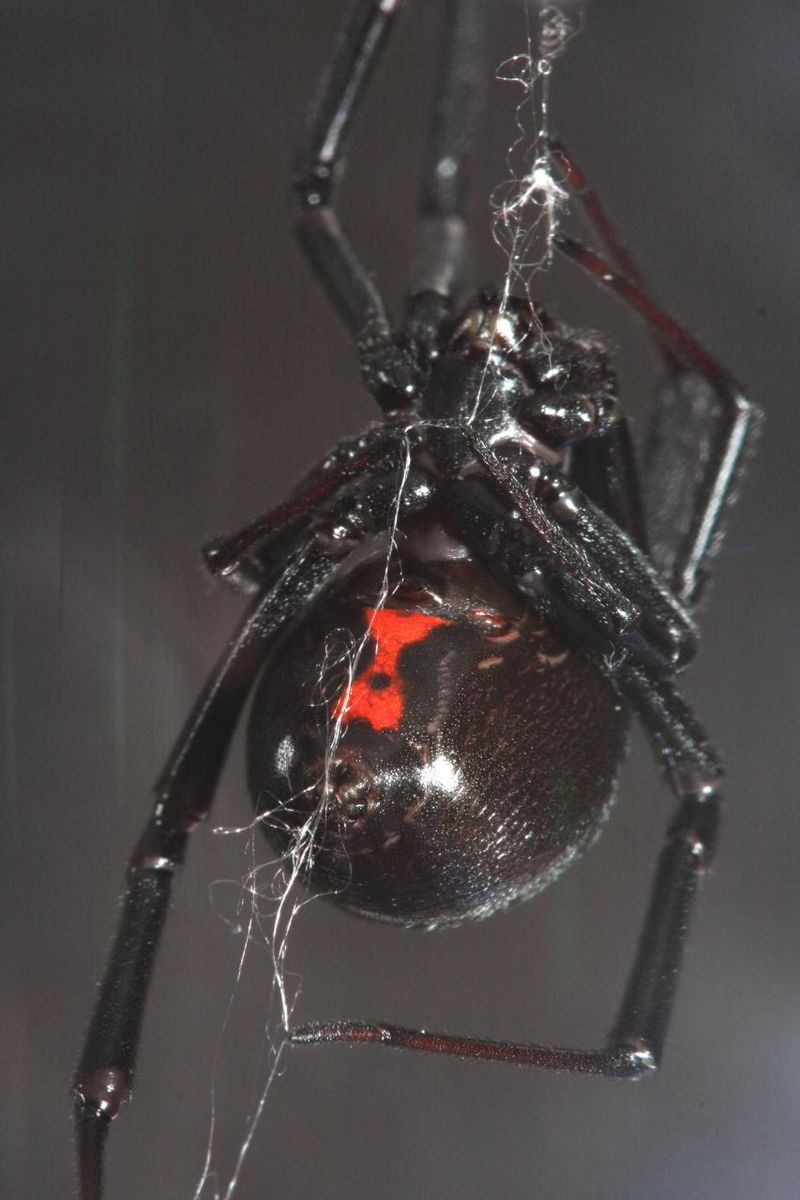
Scientific name: Latrodectus hesperus
Common name: western black widow, western widow.
The Western black widow is a venomous spider found in North America with females growing to 16mm in body length.
Females are the venomous spider, males are not as dangerous. Females can be identified for their black and shiny body with a red hourglass shape under their abdomens. In some cases, the hourglass may be yellow or white.
Males are tan with stripes on their abdomen.
If bitten by a female black widow, seek urgent medical treatment, as symptoms range from severe pain to sweating and nausea. Luckily bites are rare.
Further Reading:
3. Giant Crab Spider

Scientific name: Olios giganteus.
Common name: giant crab spider.
Giant crab spiders are also known as golden huntsman spiders and are one of the largest spiders you will encounter throughout North America. Their body can fit in the palm of an adult hand, excluding their legs.
The rounded abdomen has a stripe that runs down the center, ending in a point. The head space (cephalothorax) and legs are sandy brown with short hairs with the tips of the feet being a darker shade.
They are very fast and can also jump when ambushing their prey.
They do wander into homes now and then, though they prefer desert areas.
Further Reading:
4. Western Spotted Orbweaver

Scientific name: Neoscona oaxacensis
Common name: western spotted orbweaver, zig-zag spider.
Western spotted orbweavers are members of the orb-weaver family, known for their circular webs.
They prefer areas with sparse foliage where the spider sits upside down in the center of the web, waiting for prey to entangle themselves.
They have a bulb-shaped abdomen which is brown with yellow patches on the sides and a brown line that runs through yellow triangles on the center. There are yellow dots that run down to the abdomen.
They prefer empty logs, gardens, parks, and open fields where they are mostly encountered during the autumn when the females lay their eggs.
5. Green Lynx Spider

Scientific name: Peucetia viridans
Common name: green lynx spider.
Green lynx spider females can grow to 0.87 inches (22mm) in body length, with males being smaller, growing to 0.47 inches (12mm) in body length.
They usually have a red patch between the eyes and some red spots on the body.
They have white hairs on the eye region.
There are six chevron markings with the points facing forward under the abdomen.
They have green to yellow legs with black spines and scattered black spots.
They change color from green to pale yellow with red streaks late in the season, while gravid females change color based on their environment. Changing color can take two weeks.
6. Camptocosa parallela
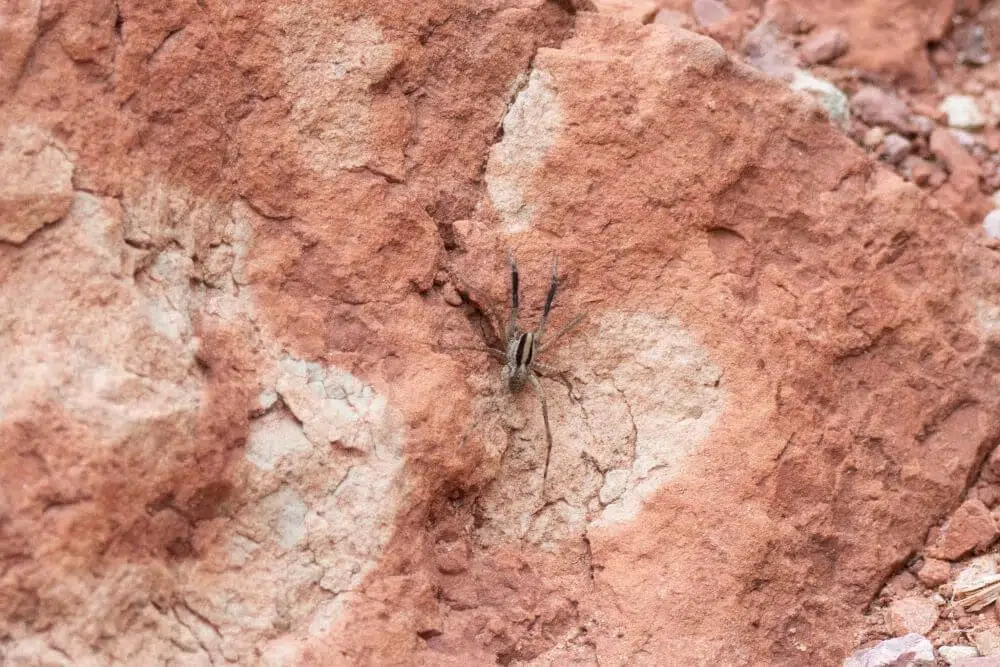
This is a type of wolf spider found in Mexico and the United States, growing to around 7mm in body length for females and 6mm in body length for males.
Females and males look very similar, though the males, once adult, have black hairs on their tibia.
7. Arizona Black Hole Spider
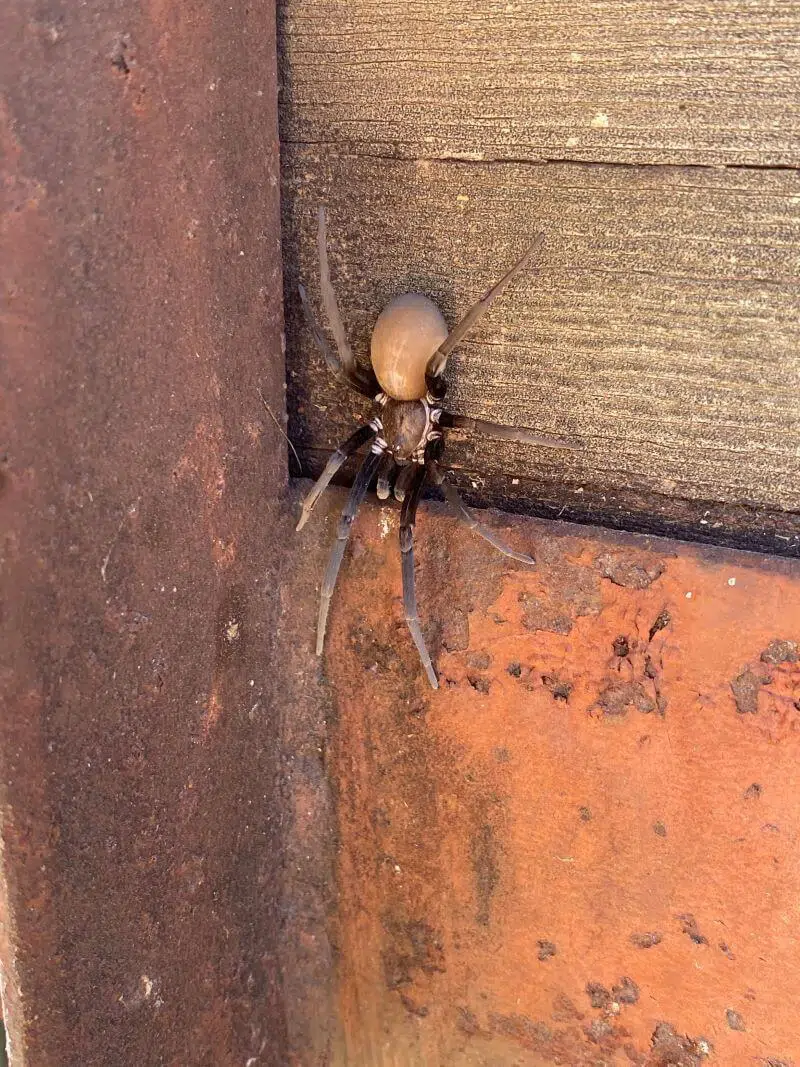
Scientific name: Kukulcania arizonica.
Common name: Arizona black hole spider.
The Arizona black hole spider belongs to the Filistatidae family and is endemic to Arizona and surrounding states, including Nevada, California, and New Mexico.
This spider is black with a velvet look. They often spin their webs in building crevices.
Females are larger than males and can grow to 13mm in body length. The male is smaller with a thinner body and longer legs.
8. Varacosa gosiuta
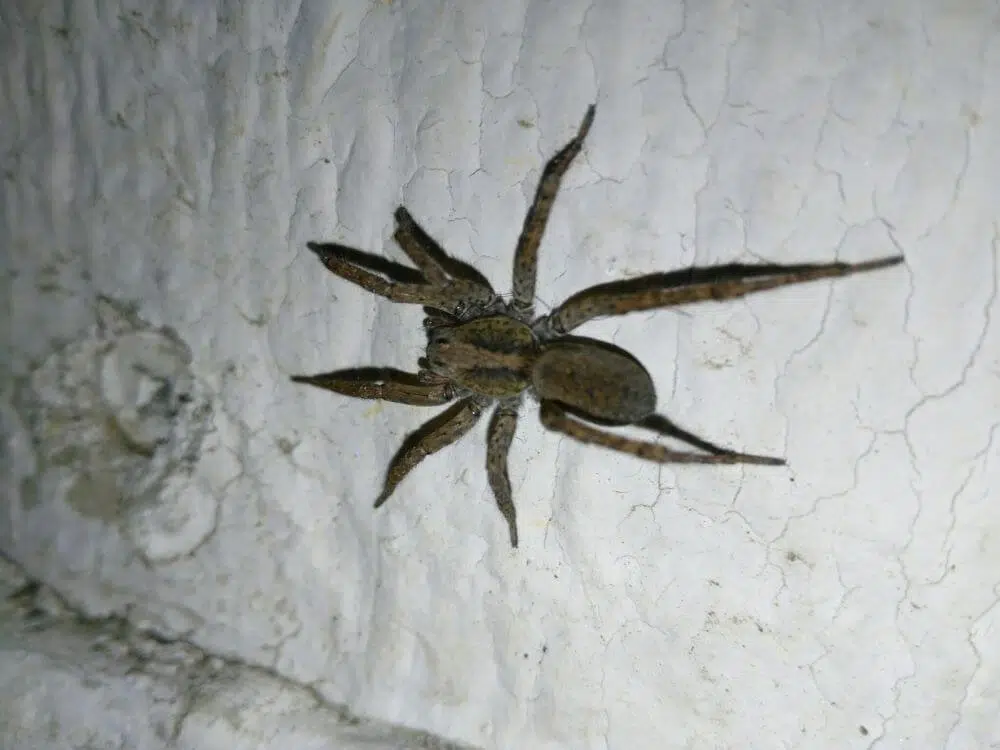
This is another of the wolf spiders you may encounter in Arizona, belonging to the Lycosidae family.
This spider was first described in 1942 and is one of six of the wolf spiders of North America.
9. Grand Canyon Black Tarantula

Scientific name: Aphonopelma marxi.
Common name: Grand canyon black tarantula.
The Grand Canyon black tarantula is a dark brown to black colored tarantula that is large and hairy. It has red to orange hairs on its abdomen.
Females are larger than males with their carapace being up to 0.60 inches (3.5cm) in length, while males only grow to 10.5mm.
This is a widely distributed spider that is considered common in north Arizona, even though they are seldom encountered, due to remaining hidden in their burrows, which are not easy to find.
10. Tucson Bronze Tarantula

Scientific name: Aphonopelma vorhiesi.
Common name: Tucson Bronze Tarantula.
The Tucson bronze tarantula is a large spider that is black to brown in color with black hairs on the legs.
They are docile and tend to remain hidden. They are not aggressive unless they feel threatened or are provoked. They are not often encountered as they remain hidden, usually creating burrows in tree trunks, under stones, and logs.
11. Phidippus carneus

This is a jumping spider from the Salticidae family that is commonly found in the United States.
These spiders use an ambush method to catch prey. They can jump four times their body length at lightning speeds, which helps them capture prey, which they drag back to their web, or escape predators, including curious humans.
They are not dangerous to humans and if bitten, it is not considered medically significant.
12. Western Parson Spider

Scientific name: Herpyllus propinquus.
Common name: western parson spider.
The Western Parson spider has a white stripe that resembles a ruffled necktie worn by the 18th century clergy.
This is a hairy spider that is fast and medium in size.
They are nocturnal and spend their night climbing walls and the ground searching for insects.
They are ambush predators and do not rely on their webs to entangle prey.
They prefer woodland areas but are known to wander into homes.
Their bites are not considered dangerous though some people do experience an allergic reaction.
13. Marbled Cellar Spider

Scientific name: Holocnemus pluchei.
Common name: marbled cellar spider.
The marbled cellar spider is also known as a daddy long legs, which can be found throughout the North Pacific area of the United States.
They are common household spiders that create webs in basements, house eaves, and attics.
There is very little size difference between the males and females, they have long legs with black and white circles on the joints.
14. Hirsute Paradise Spider

Scientific name: Habronattus hirsutus.
Common name: Hirsute paradise spider.
The Hirsute Paradise spider is a jumping spider from the Salticidae family and is native to North America.
They are colorful and do fantastic complex dances as part of their courtship.
They are not considered medically significant, though a bite from one of these jumping spiders will cause redness, swelling, and pain in the bite area for up to two days.
15. Banded Garden Spider

Scientific name: Argiope trifasciata
Common name: banded garden spider, banded orb weaving spider.
The banded garden spider can be red to brown with white bands or black with yellow and white bands. They darken with age.
The legs are banded in the same colors as the body with a wide and round abdomen.
They build webs close to the ground between tall grass and shrubs.
The spider sits in the center of the web, capturing any insects that get entangled in the web.
16. Colonus hesperus

The Colonus hesperus is a jumping spider that belongs to the Salticidae family and is common in Arizona.
They are not dangerous to humans and are more likely to jump away at fast speeds to get away from curious humans.
These ambush spiders do not use their webs to entangle prey, but rather drag the prey back to their web where they can eat in privacy and security.
17. False Black Widow

Scientific name: Steatoda grossa.
Common name: False black widow, cupboard spider.
The false black widow, also known as the cupboard spider is common in Arizona.
The female can grow to 10.5mm in body length and have a dark-colored bulb-shaped abdomen.
Colors can range from black to purple and brown with lighter colored markings. They do not have the red hourglass under their abdomen, as you would find with a black widow.
While the bite from one of these spiders is considered medically significant, the symptoms are not as bad as you would get if bitten by a black widow.
18. Carolina Wolf Spider
Scientific name: Hogna carolinensis.
Common name: Carolina wolf spider.
This spider is a hunting spider that goes out to look for food, rather than waiting for it to get entangled in its web.
They are nocturnal and not encountered often.
Their bodies are black to brown, helping them blend in with the forest floor.
They are known to wander into homes looking for their next prey.
These large, fast and hairy spiders have a tan line down the center of the head space with brown or black on the sides. Their almond-shaped abdomen has a chevron pattern near the back with females being larger and darker than the males.
19. Chiricahuan Gray Tarantula

Scientific name: Aphonopelma gabeli.
Common name: Chiricahuan gray tarantula.
The Chiricahuan gray tarantula belongs to the Theraphosidae family and is common in Arizona. It was previously known as the Aphonopelma sp. Carisbad green.
This is a New World tarantula that comes from the Chinuahhuan desert it is back and gray and sometimes has a tint of green, especially after molting.
They grow to around 6 inches and are not considered harmful to humans.
20. Golden Jumping Spider

Scientific name: Paraphidippus aurantius.
Common name: emerald jumping spider, golden jumping spider.
The golden jumping spider has white stripes on the side of the head and a white border running along the top of the abdomen.
Females are brown with orange and metallic green on the abdomen and cephalothorax, which is reflective when you shine a light onto the spider.
These spiders are fantastic jumpers and can jump up to four times their body length at fast speeds, which they use to ambush prey and escape predators.
They do not generally bite unless provoked, the bite is not medically significant and will heal on its own.
21. White-banded Crab Spider

Scientific name: Misumenoides formosipes
Common name: white banded crab spider.
The white-banded crab spider belongs to the Thomisidae family and has a white line running through the eyes.
They are sit-and-wait predators, waiting in flowers and on stalks to catch pollinating insects. They use their strong front legs to seize any prey.
Females are larger than males and have variable colors on the body which can range from yellow to white, depending on the surroundings.
Males do not change color and their four front legs are darker in color than the female and they have a golden abdomen.
Females can grow to 0.44 inches (11.3mm) with a rounded triangular shape at their posterior. Males grow to 0.13 inches (3.2mm) with a golden abdomen that cannot change in color.
22. Six-spotted Fishing Spider
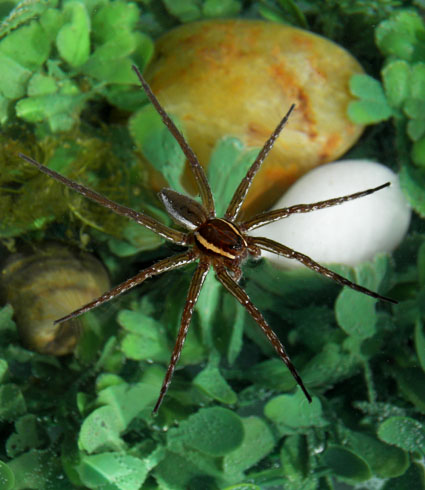
Scientific name: Dolomedes triton.
Common name: six-spotted fishing spider, dock spider.
Six spotted fishing spiders are members of the nursery web spider family and are common in wetland habitats in North America, usually seen on the surface of the water.
They are large in size with distinctive markings.
They have excellent vision with a gray to brown body. There is a pale cream to white stripe that runs down either side of the head space with light-colored dots on the abdomen. Underneath they have six dark spots.
Females can grow to 0.79 inches (20mm) in body length, with males growing to 0.51 inches (13mm) in body length.
These spiders are semi-aquatic and prefer wetland habitats.
23. Anyphaena dixiana
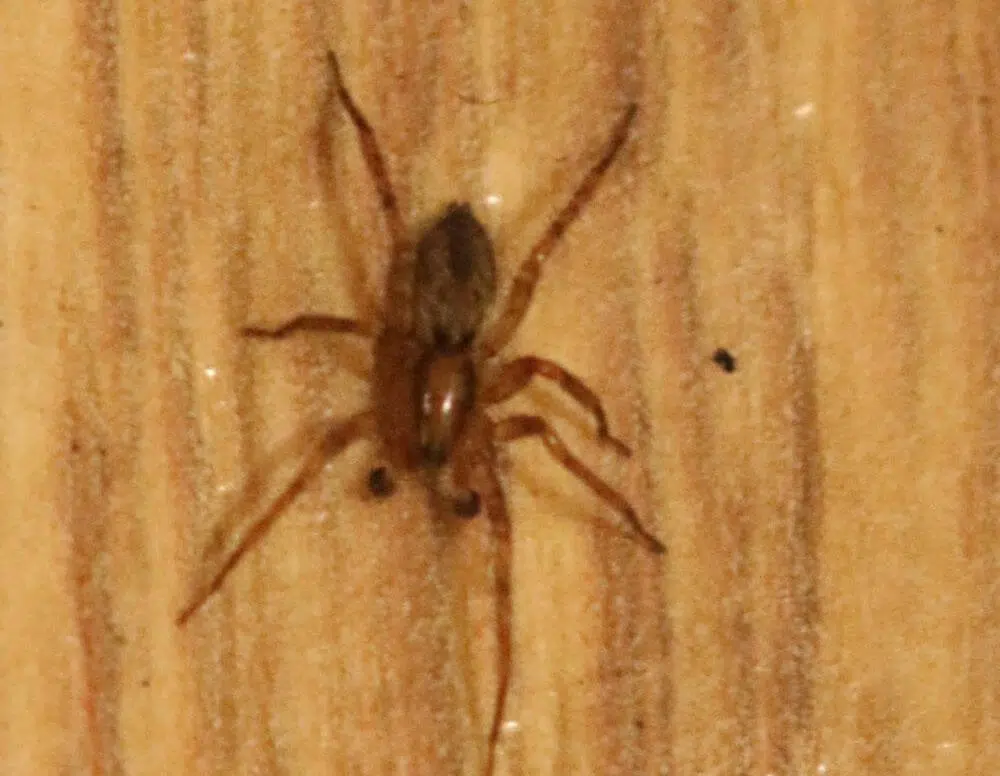
This is a ghost spider from the Anyphaenidae family with females growing up to 14mm and males to 3.85mm in body length.
They prefer alfalfa, often found under dead agave and in homes.
Males are mostly seen from Mid August to Mid May, with females being encountered from late September to late April.
24. Habronattus pyrrithrix
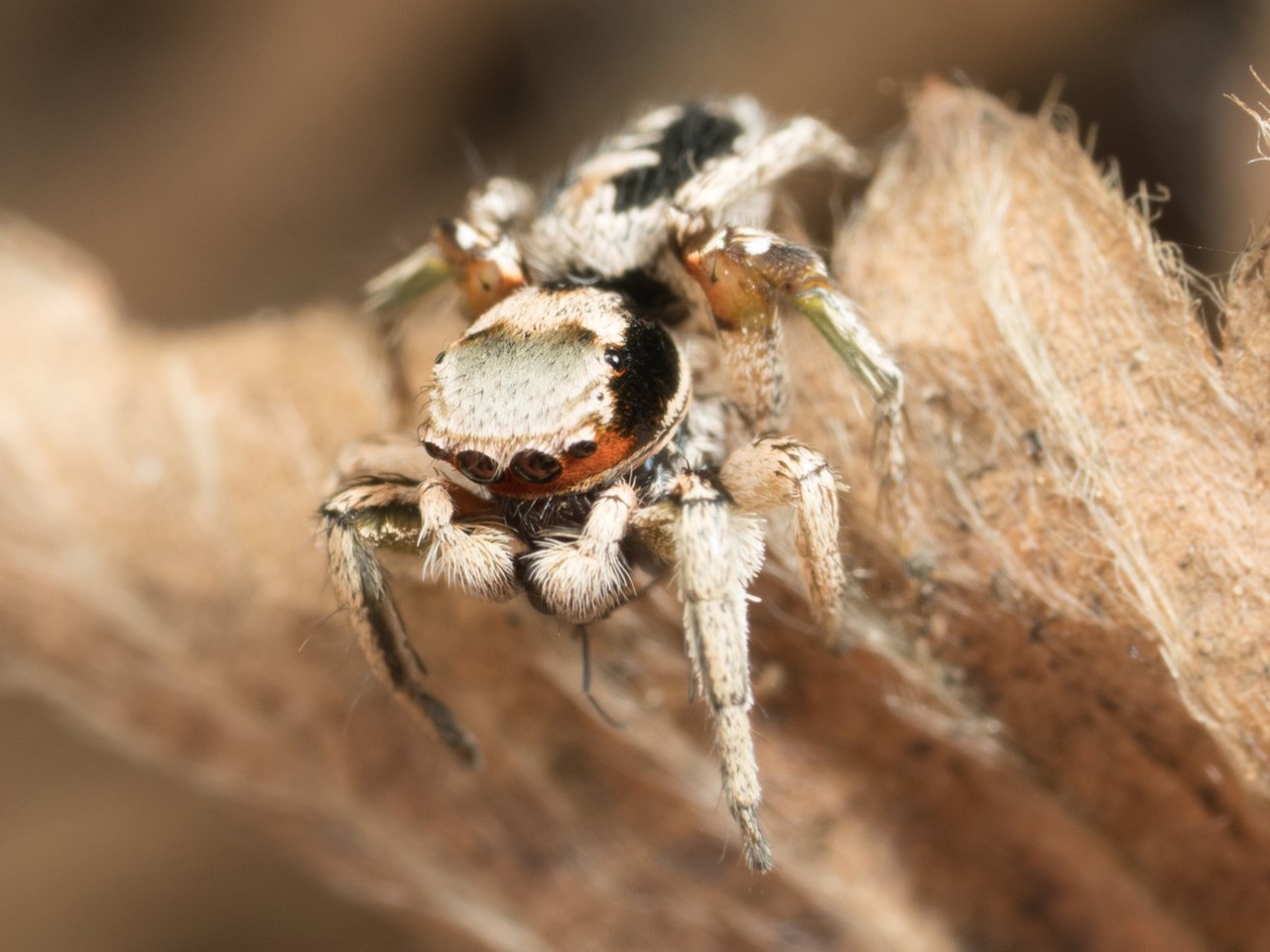
This is a jumping spider from the Salticidae family and is common in the southwestern United States.
Males have bold black stripes, while females remain uniform in color.
These ambush spiders use their excellent jumping abilities to jump and capture prey, their jumping and speed also help them escape predators.
25. Koch’s Wolf Spider

Scientific name: Alopecosa kochi.
Common name: Koch’s wolf spider.
Koch’s wolf spiders belong to the Lycosidae family and are found in Arizona, where it is mostly observed in April.
These spiders remain hidden and sometimes wander into homes looking for insects.
They are not considered medically significant and bites are rare, as they tend to hunt at night.
26. Long-bodied Cellar Spider

Scientific name: Pholcus phalangioides
Common name: daddy long-legs spider, long-bodied cellar spider, skull spider.
The long-bodied cellar spider has a tubular-shaped abdomen, they are also referred to as daddy long legs.
They have long legs that are spindly and they tend to bounce on their webs to blur themselves from anyone watching them.
They use their webs to capture prey while they hang upside down.
They have tiny mouth parts, which makes them unable to bite humans.
Though they are considered venomous, the short fangs are too small to inject venom into a human.
27. Goldenrod Crab Spider

Scientific name: Misumena vatia.
Common name: goldenrod crab spider, flower (crab) spider.
The goldenrod crab spider has the ability to camouflage as a defense mechanism. It will bite to protect itself.
They can change color over a number of days to blend in with their surroundings.
This ambush spider does not spin webs to entangle their prey, they jump on their prey. They sit in the center of a flower, usually a Goldenrod, and wait for pollinating insects to collect pollen.
The spider uses its long strong front legs to hold onto its prey, immobilizing it with a bite and then dragging it back to its web.
The male Goldenrod crab spider is dark with black front legs and pale green back legs and a cream to white-colored abdomen, which has two red lines that run down the center. Females have pale-colored legs and a rounder and plumper abdomen.
28. Shoreline Wolf Spider

Scientific name: Arctosa littoralis
Common name: shoreline wolf spider.
The shoreline wolf spider is also referred to as the beach wolf spider and belongs to the Lycosidae family, common in Central and North America.
These are hunting spiders that do not rely on their webs to catch prey, but rather hunt the shoreline in search of food.
29. Apache Jumping Spider

Scientific name: Phidippus apacheanus.
Common name: Apache jumping spider.
This jumping spider belongs to the Salticidae family and is common in the Great Plains, observed mostly between Septerm and October.
This small jumping spider is an ambush spider that can jump considerable distances at a fast speed for its small size.
They are not harmful to humans and are usually just as curious about us as we are of them. They will only bite if provoked, which will cause pain and stinging for a few days.
30. Madera Canyon Tarantula

Scientific name: Aphonopelma madera.
Common name: Madera Canyon Tarantula.
This spider belongs to the Theraphosidae family and is common to Arizona. This is a New World terrestrial tarantula and is considered to be the only species found at high elevations.
They prefer dry habitats and are burrowers, creating shallow burrows under rocks and logs. They are black, large, hairy, and not dangerous to humans.
31. Yellow Garden Spider

Scientific name: Argiope aurantia
Common name: yellow garden spider, black and yellow garden spider, golden garden spider, writing spider, zigzag spider, zipper spider, black and yellow argiope, corn spider, Steeler spider, McKinley spider.
Yellow garden spiders are black and yellow and were first described in 1833.
Their cephalothorax or head space is mostly white.
Females are larger than males growing to 1.10 inches (28mm) in body length, males grow to 0.35 inches (9mm) in body length.
They are completely harmless to humans with their bite no worse than a bumblebee sting
32. Cat-faced Orbweaver

Scientific name: Araneus gemmoides.
Common name: Cat-faced spider, jewel spider.
Cat-faced orbweavers and are completely harmless to humans with a cat face on the abdomen, created by two bumps, forming the ears of the cat.
They usually hang upside down and tend to vary in color. Some are rich brown, while others are pale.
33. Ribbon Jumping Spider

Scientific name: Metacyrba taeniola
Common name: Ribbon Jumping Spider.
The ribbon jumping spider belongs to the Salticidae family with females growing to 0.28 inches (7.2mm) and males to 0.24 inches (6mm) in body length.
They are harmless to humans and use their excellent jumping ability to ambush prey and escape predators, including curious humans. They do not rely on their web to entangle prey, but rather drag any prey back to the web, where they can consume it in comfort and privacy.
34. Agave Jumping Spider

Scientific name: Paraphidippus basalis.
Common name: Agave jumping spider.
The Agave jumping spider belongs to the Salticidae family and is common in New Mexico and Arizona. They are found on rosette-forming plants, such as yuccas and agaves.
They ambush their prey by jumping at them while releasing a single strand of silk, which helps to keep their prey captured until the spider can get it back into its web and consume it.
35. Habronattus clypeatus

This is another of the common jumping spiders found in Arizona.
These spiders can jump up to four times their body length and at fast speeds. They use this when ambushing their prey or to escape threats.
They will bite if provoked, which will cause localized stinging and redness for a few hours.
36. California Flattened Jumping Spider

Scientific name: Platycryptus californicus
Common name: California Flattened Jumping Spider
Also present in Arizona, this type of flattened spider has a central gray section across its cephalothorax and abdomen.
The shape of this gray pattern is often compared to a leaf while the rest of its body is mostly black.
Some spiders additionally show orange spots on the central gray sections across the dorsum.
Its legs show a combination of gray and black nuances as well.
Commonly spotted around homes, California Flattened Jumping Spiders also show a fine white stripe along the edges of the cephalothorax as a distinguishing characteristic.
This is a type of spider that may as well eat other types of spiders, relying on its agility to catch them.
It pounces on spiders directly instead of building a classic spider web.
California Flattened Jumping Spiders can bite, but mostly when roughly handled.
This is a spider species that doesn’t cause severe reactions with its bite, apart from a sharp initial pain that subsides within a few hours
37. Desert Tarantula

Scientifica name: Aphonopelma iodius
Common name: Desert Tarantula, California Tarantula
One of the species also present in the state with a scary appearance is The Desert Tarantula.
This is a species that easily lives both in the desert and in woodlands, sometimes making its way indoors.
With a body size of around 2 inches, tarantulas of this genus are dominated by bright brown nuances.
Males are considerably brighter as they show tan to brown nuances on the body and dark brown nuances on the legs.
Females only show a bright brown appearance on the thorax while being mostly dark brown to black.
38. Desert Red Jumping Spider

Scientific name: Phidippus ardens
Common name: Desert Red Jumping Spider
One of the scariest spiders in Arizona, Desert Red Jumping Spiders are sometimes confused with Black Widows.
This is a species that shows a red abdomen with black central stripes or an orange-red abdomen contrasted by a black appearance otherwise.
This makes it similar to the red-marked venomous Black Widows.
Further differences between the species include the shape of the red mark on the abdomen which is in the form of wide stripes instead of an hourglass marking.
Males of this species also show blue mouthparts as a distinguishing trait.
39. Spotted Orbweaver

Scientific name: Neoscona crucifera
Common name: Spotted Orbweaver, Barn Spider
Brown nuances are also specific to The Spotted Orbweaver, a species that also shows white spots on the ventral side of its abdomen.
Small black dots are seen on its dorsal abdomen as well as on its legs.
Spotted Orbweavers are a recognizable species as they also live close to humans, particularly in attics, the garage, or around farms where flies are numerous.
Spread around the state, these types of spiders build actual spider webs, mostly in areas where these webs aren’t easily destroyed.
A small species of around 0.4 inches, Spotted Orbweavers can also grow to a maximum size of around 0.7 inches.
Further Reading: